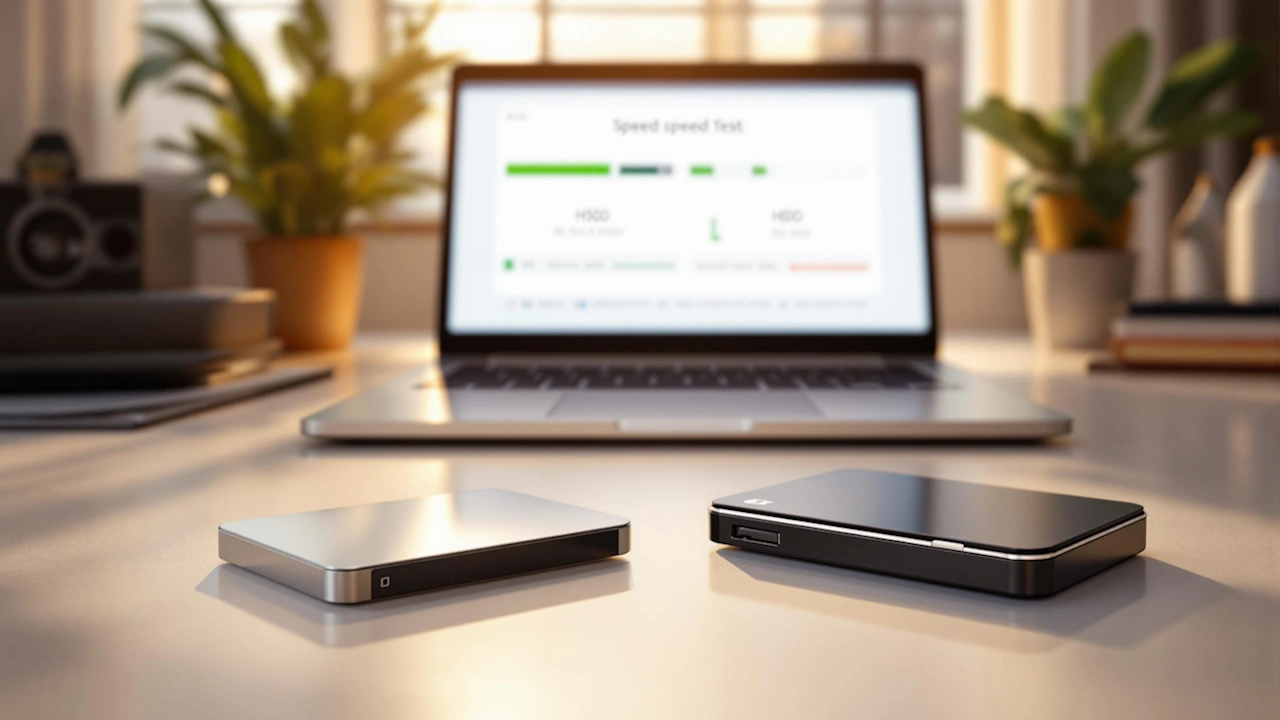Hardware Components
SSD vs HDD: Which Storage Drive Is Right for You?
SSD vs HDD: Which Storage Drive Is Right for You?
When deciding between SSDs and HDDs, it boils down to speed, cost, and storage capacity. SSDs are faster, more durable, and use less power, making them ideal for performance-focused tasks like gaming and video editing. On the other hand, HDDs are cheaper and offer larger storage capacities, making them better for backups and bulk data storage. Here’s a quick comparison to help you choose:
| Feature | SSD | HDD |
|---|---|---|
| Speed | 500–3,500 MB/s | 30–150 MB/s |
| Durability | No moving parts, shock-resistant | Mechanical parts, less durable |
| Cost per GB | £0.08–0.10 | £0.03–0.06 |
| Capacity | Up to 4TB (common) | Up to 20TB (common) |
| Best For | Speed and reliability | Affordable mass storage |
Quick Tip:
- Need speed? Go for an SSD.
- Need large, affordable storage? Choose an HDD.
- Want both? Pair an SSD for your OS/apps with an HDD for storage.
Keep reading for a deeper dive into how these technologies work and their best use cases.
SSD and HDD Basics
Understanding how SSDs and HDDs operate helps explain their performance differences and best applications. These two storage technologies handle data in distinct ways.
SSD Technology
SSDs rely on NAND flash memory to store data, even when the power is off. They use floating-gate transistors to trap electrons, representing binary data. Many modern SSDs use 3D NAND, where memory cells are stacked vertically, boosting storage capacity and efficiency. This design enables extremely fast data access without any moving parts.
Some key features of SSDs include:
- Wear leveling: Spreads data evenly across memory cells, prolonging the drive’s lifespan.
- TRIM: Improves write performance by removing redundant data before writing.
HDD Technology
HDDs, on the other hand, use a mechanical design that has been refined over decades. They store data on magnetic platters that spin at high speeds, typically 7200 RPM. A read/write head, controlled by an actuator arm, moves across the platters to access or modify data by detecting changes in magnetic polarization.
"HDDs and SSDs each possess distinct strengths, making them suited to different tasks within the datasphere. Far from being adversaries, these technologies are complementary, and together offer a balanced, effective approach to data storage that caters to the diverse needs of today’s digital world." – Seagate [4]
This mechanical design is why HDDs remain dominant in data centers, where they account for more than 90% of cloud storage capacity [4].
| Feature | HDD | SSD |
|---|---|---|
| Storage Method | Magnetic platters | Flash memory chips |
| Data Access | Mechanical (read/write head) | Electronic (memory controller) |
| Moving Parts | Yes (spinning disks, actuator arm) | None |
| Data Transfer Speed | 30-150 MB/s | 500-3,500 MB/s |
| Primary Advantage | Affordable mass storage | Lightning-fast access |
These fundamental differences highlight how each technology excels in specific scenarios, balancing performance and cost effectively.
SSD vs HDD: Main Differences
When deciding between SSDs and HDDs, focus on three key aspects: speed, durability, and price.
Performance Speed
SSDs rely on flash memory instead of spinning disks, giving them a clear edge in speed. HDDs typically max out at around 250MB/s for read/write speeds, while even entry-level SATA SSDs double that performance [7]. The difference becomes even more pronounced with advanced options: PCI Express Gen 4 SSDs achieve speeds up to 7,000MB/s, and the latest PCI Express 5.0 drives surpass 10,000MB/s [7].
| Task | HDD | SSD | Impact |
|---|---|---|---|
| System Boot | 30–40 seconds | 10–15 seconds | Faster startup |
| Game Loading | 30–40 seconds | 10–15 seconds | Reduced wait times |
| File Transfer | 30–150 MB/s | 500–3,500 MB/s | Smoother file handling |
The physical design of these drives also plays a role in their overall performance and durability.
Physical Reliability
SSDs tend to outlast HDDs because they have no moving parts. This design makes SSDs:
- Resistant to shocks
- Better at handling extreme temperatures
- Quieter in operation
- More energy-efficient
Storage Size and Price
HDDs still dominate when it comes to cost per gigabyte, ranging from £0.03 to £0.06 per GB compared to SSDs at £0.08 to £0.10 per GB [2]. Here’s a look at current SSD pricing [8]:
| Capacity | Price Range |
|---|---|
| 256GB | £15–25 |
| 512GB | £25–40 |
| 1TB | £50–75 |
| 2TB | £90–150 |
| 4TB | £150–300 |
If you need large storage at a lower price, HDDs are the better choice, as they offer higher capacities for less money [1]. Weighing these price differences is essential when determining the best storage solution for your needs.
Best Uses for Each Drive
Best SSD Applications
Modern SSDs offer unmatched speed and reliability, making them a game-changer for tasks like gaming. For example, in testing Grand Theft Auto V, loading times dropped from over two minutes on a traditional HDD to just 25 seconds with a Samsung 970 Evo Plus SSD [3].
Even major esports organizations like Riot Games rely on SSDs for top-tier performance. Here’s what they had to say about Samsung SSDs in their League of Legends Championship Series:
"After testing, we chose Samsung SSDs as our official LCS memory partner to give players the best performance and speed during crucial split-second reaction times, and the reliability to keep performing through every game of the season." [9]
SSDs also shine in reliability, with an annualized failure rate of just 0.58%, compared to 10.56% for HDDs [9]. This makes them perfect for systems where reliability is key, such as mobile workstations, content creation setups, and mission-critical applications.
Best HDD Applications
While SSDs dominate in speed and reliability, HDDs are the go-to option for affordable, high-capacity storage. They’re ideal for situations where storage volume takes priority over speed.
A hybrid approach can help balance performance and cost. Apple’s Fusion Drive, introduced in 2012, is a great example of combining SSD speed with HDD capacity [10]. This setup works particularly well in scenarios like:
| Use Case | Benefits | Example Application |
|---|---|---|
| Data Archives | Affordable long-term storage | Historical records, compliance data |
| Media Libraries | Handles large files easily | Video collections, photo archives |
| Network Storage | Shared storage on a budget | Home media servers, backup systems |
| Budget Systems | Maximum storage for less | Student computers, basic workstations |
Seagate’s research highlights how hybrid drives (SSHDs) can improve load times by up to 5x compared to traditional HDDs while keeping costs low. For instance, a 2TB Seagate FireCuda SSHD (with 8GB flash storage) costs £238.26, significantly less than a comparable all-flash SSD at £325.69 [11].
Making Your Choice
Choosing between an SSD and HDD comes down to performance, storage needs, and budget. Here’s a simple guide to help you decide:
For tasks that demand speed, SSDs are the clear winner, cutting boot times from minutes to seconds [3]. Below is a table to match your budget and storage needs:
| Budget | Primary Need | Recommended Solution | Typical Cost |
|---|---|---|---|
| Limited | Large Storage | 1TB HDD | ~£60 |
| Medium | Balance | 250GB SSD + 1TB HDD | ~£120–£150 |
| High | High Performance | 1TB NVMe SSD | ~£120+ |
This approach ensures your storage setup aligns with your specific needs.
For those looking for flexibility, a hybrid setup can be a great choice. Use a 250–500GB SSD for your operating system and frequently used applications to maximize speed. Pair this with a larger HDD for storing media, documents, and other data that doesn’t require fast access. This offers a cost-effective solution, with HDDs priced at around £60 per terabyte.
Now, consider your primary tasks:
- Content Creation: A modern NVMe SSD handles 4K video editing and rendering with ease [3].
- Gaming: A hybrid setup is ideal. Use an SSD for current games to enjoy faster load times, and an HDD for older or less demanding titles.
- Professional Workstation: Combine an NVMe SSD for active applications with HDD storage for bulk data.
One standout example is the E-HASH system, which achieves a 72% reduction in I/O response time compared to traditional RAID setups, along with a 61% drop in energy consumption [12]. This makes hybrid storage an appealing option for those who want both speed and cost efficiency.
Conclusion
Choosing between SSDs and HDDs comes down to balancing speed and storage capacity. SSDs are known for their speed and reliability, making them perfect for tasks like video editing and gaming. On the other hand, HDDs are a more affordable choice for storing large amounts of data.
Since 2018, when HDD shipments fell to 124 million units [6], the storage market has expanded significantly. Brands like Samsung, Western Digital, and Crucial now offer a variety of options tailored to different needs. Whether you’re looking for new or refurbished solutions, reputable vendors provide plenty of choices.
While SSDs are faster and more durable, HDDs still have their place, especially for backups and archives. Data recovery is often simpler with HDDs [6], which makes them a reliable option for safeguarding critical files.
Ultimately, the decision depends on your priorities. SSDs shine in high-performance scenarios with their durability, quiet operation, and lower energy use [5]. Meanwhile, HDDs remain a cost-effective solution for large-scale storage. No matter your needs or budget, there’s a storage option out there for you.

